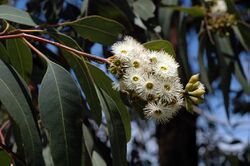Biology:Eucalyptus ancophila
| Eucalyptus ancophila | |
|---|---|

| |
| Eucalyptus ancophila in the Waite Arboretum | |
| Scientific classification | |
| Kingdom: | Plantae |
| Clade: | Tracheophytes |
| Clade: | Angiosperms |
| Clade: | Eudicots |
| Clade: | Rosids |
| Order: | Myrtales |
| Family: | Myrtaceae |
| Genus: | Eucalyptus |
| Species: | E. ancophila
|
| Binomial name | |
| Eucalyptus ancophila L.A.S.Johnson & K.D.Hill[2]
| |
Eucalyptus ancophila is a tree endemic to a small area of New South Wales in eastern Australia. It has grey "ironbark", glossy green, lance-shaped leaves, flower buds arranged in a branching inflorescence with seven oval to diamond-shaped buds in each umbel, white flowers and conical or barrel-shaped fruit.
Description
Eucalyptus ancophila is a tree with rough, grey "ironbark" that grows to a height of 35 m (100 ft), sometimes with smooth pale grey bark on its thinner branches. Young plants and coppice regrowth have four-sided stems and egg-shaped, later lance-shaped leaves, that are a paler shade of green on the lower side. The blade of the adult leaves are lance-shaped 90–200 mm (4–8 in) long and 18–4.8 mm (0.7–0.2 in) wide and only slightly paler on the lower side. The flower buds are arranged in a branching inflorescence, each branch with an umbel of seven buds. The groups have a peduncle 3–14 mm (0.1–0.6 in) long and the individual flowers a pedicel 3–6 mm (0.1–0.2 in) long. The buds are oval to diamond-shaped, 6–7 mm (0.2–0.3 in) long and 3–5 mm (0.1–0.2 in) wide with a beaked to conical operculum that is shorter and narrower than the flower cup. Flowering has been recorded in November and the flowers are white. The fruit is a cone-shaped or barrel-shaped capsule 5–8 mm (0.2–0.3 in) long and 5–7 mm (0.2–0.3 in) wide on a pedicel 3–5 mm (0.1–0.2 in) long.[3][4][5]
Taxonomy and naming
Eucalyptus ancophila was first formally described in 1990 by Lawrie Johnson and Ken Hill and the description was published in Telopea from a specimen collected near Kempsey.[2] The specific epithet (ancophila) is from the Ancient Greek words ankos meaning "mountain glen" or "valley"[6]:830 and philos, meaning "dear one" or "friend"[6]:355 referring to this species' habitat.[5]
Distribution and habitat
This eucalypt usually grows along creeks or in the bottom of valleys in the Kempsey and Bellingen districts.[4][5]
References
- ↑ Fensham, R.; Laffineur, B.; Collingwood, T. (2019). "Eucalyptus ancophila". IUCN Red List of Threatened Species 2019: e.T133381377A133381379. doi:10.2305/IUCN.UK.2019-3.RLTS.T133381377A133381379.en. https://www.iucnredlist.org/species/133381377/133381379. Retrieved 20 September 2021.
- ↑ 2.0 2.1 "Eucalyptus ancophila". APNI. https://id.biodiversity.org.au/instance/apni/456287.
- ↑ Hill, Ken. "Eucalyptus ancophila". Royal Botanic Garden Sydney. http://plantnet.rbgsyd.nsw.gov.au/cgi-bin/NSWfl.pl?page=nswfl&lvl=sp&name=Eucalyptus~ancophila.
- ↑ 4.0 4.1 "Eucalyptus ancophila". Centre for Australian National Biodiversity Research. http://keyserver.lucidcentral.org:8080/euclid/data/02050e02-0108-490e-8900-0e0601070d00/media/Html/Eucalyptus_ancophila.htm.
- ↑ 5.0 5.1 5.2 Johnson, Lawrence A.S.; Hill, Kenneth (26 September 1990). "New taxa and combinations in Eucalyptus and Angophora (Myrtaceae)". Telopea 4 (1): 82–83. doi:10.7751/telopea19904916.
- ↑ 6.0 6.1 Brown, Roland Wilbur (1956). The Composition of Scientific Words. Washington, D.C.: Smithsonian Institution Press.
Wikidata ☰ Q15397505 entry
 |


